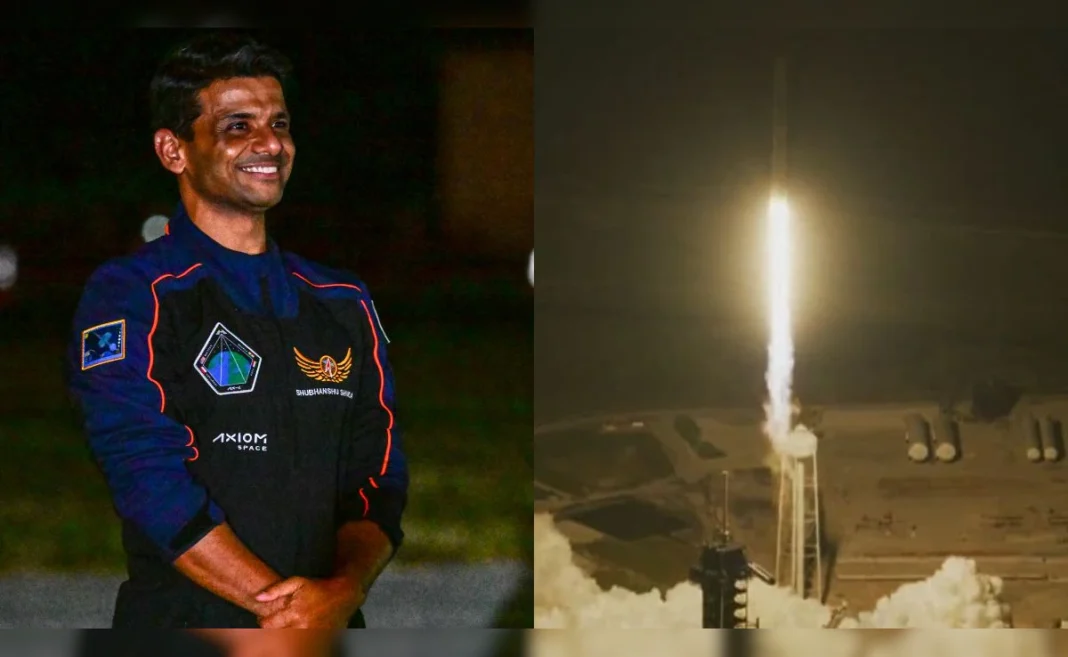
In a landmark moment for global space exploration, the Axiom-4 mission has successfully launched from NASA’s Kennedy Space Center in Florida. This mission is historic not only for its objectives but also because it features Shubhanshu Shukla, an Indian-origin astronaut who is now en route to the International Space Station (ISS). The mission was executed by Axiom Space in partnership with NASA and SpaceX, making it another example of how private and public sectors are coming together to redefine humanity’s presence in space. The spacecraft, mounted on a SpaceX Falcon 9 rocket, blasted off precisely on schedule and entered Earth’s orbit as planned, marking a flawless beginning to an ambitious and inspiring mission.
Indian-Origin Astronaut Shubhanshu Shukla Takes Flight
One of the most talked-about aspects of the Axiom-4 mission is the participation of Shubhanshu Shukla, whose journey is being celebrated as a moment of great pride for India and the Indian diaspora worldwide. Trained extensively in the United States and abroad, Shukla represents a new generation of space travelers who come not only from national space agencies but also from the growing sector of commercial spaceflight. His selection for this mission underscores India’s rising contribution to global aerospace leadership. As part of the Axiom-4 team, Shukla will play a vital role in executing onboard scientific research, conducting educational outreach, and supporting the mission’s broader goals.
The Axiom-4 Mission: A Scientific and Collaborative Endeavor
The mission is designed to last approximately 14 days aboard the International Space Station, during which the crew will carry out a wide range of scientific experiments and technology demonstrations. Unlike traditional government-funded missions, Axiom-4 showcases the potential of private space exploration to support meaningful scientific work. The research will include biomedical studies, material science tests, and even space agriculture projects. Each experiment aims to contribute valuable data not only to improve life on Earth but also to prepare for future missions to the Moon, Mars, and beyond. The emphasis on microgravity research and the testing of new technologies reflects how space missions are becoming increasingly interdisciplinary and globally significant.
The International Crew Behind Axiom-4
The crew of Axiom-4 is made up of four individuals from different countries and professional backgrounds, representing a truly international collaboration. Alongside Shubhanshu Shukla are a veteran NASA astronaut, a scientist from Europe, and a payload expert from Turkey. This diversity is not just symbolic—it’s strategic. Bringing together talent from around the world helps the mission harness varied expertise and perspectives. The team underwent months of intensive training to ensure that they could work seamlessly in the confined, high-stakes environment of the ISS. Their preparation covered everything from spacecraft operation and robotic arm control to emergency procedures and microgravity adaptation.
Why This Mission Matters for India
For India, this mission is more than just a headline—it’s a statement of intent. While legendary names like Rakesh Sharma, Kalpana Chawla, and Sunita Williams have already etched their legacy into the stars, Shubhanshu Shukla’s participation in a private space mission signals a new era. It shows that Indian professionals are being recognized on the global stage, not just in traditional government programs, but also in the fast-evolving commercial space ecosystem. This could open the door for more Indian astronauts, scientists, and engineers to play central roles in international missions in the near future. The sense of national pride was palpable across social media, where users celebrated this launch as a “moment for the history books.”
Launch Vehicle and Technical Details
The launch was executed with the help of the Falcon 9 rocket, a reusable space vehicle developed by SpaceX, which has become a backbone for modern space missions. Attached to the rocket was the Crew Dragon capsule, known for its advanced safety systems, touchscreen interface, and life support features. The rocket lifted off at 11:16 AM EDT (8:46 PM IST) from Launch Complex 39A and, within 12 minutes, successfully deployed the Crew Dragon into Earth’s orbit. This capsule will now make its way to the International Space Station, where it will dock automatically using advanced sensors and guidance systems. The docking procedure is expected to take place within 24 hours of launch.
Axiom Space: Building a Future Beyond ISS
Axiom Space, the operator of this mission, is not just another private company—it has a vision for the future of human spaceflight. It aims to construct the world’s first commercial space station that will eventually detach from the ISS and operate independently. Missions like Axiom-4 are stepping stones in this ambitious journey. The company is already working on launching dedicated modules that will initially attach to the ISS and then form the core of Axiom’s future outpost. These commercial platforms will not only support scientific research but will also host space tourists, film crews, and entrepreneurs, signaling a future where space is not just for scientists or soldiers, but for everyone.
Training, Preparation, and Human Element
The astronauts of Axiom-4, including Shubhanshu Shukla, went through an extensive preparation program that covered every conceivable aspect of life in space. They trained in neutral buoyancy labs, where underwater exercises simulate the experience of zero gravity. They practiced manual docking simulations, spacewalk preparations, and emergency evacuation drills. This kind of preparation is vital not just for mission success but for personal safety and psychological readiness. Living in space is challenging, and astronauts need to maintain both mental clarity and physical endurance. Shukla’s successful adaptation to these tests is a testament to his discipline and passion for space exploration.
Media Response and Global Attention
The Axiom-4 launch has garnered widespread media attention. News channels across the globe have described it as a major milestone in the evolution of private space travel. In India, the mission has become a topic of national discussion, with hashtags like #ShubhanshuShukla and #Axiom4 trending across platforms. Educational institutions across the country hosted watch parties and panel discussions, using the mission to inspire students to dream bigger and aim higher. This enthusiastic public response demonstrates how space missions continue to capture the world’s imagination, even in an age of technological saturation.
Life Aboard the International Space Station
After the Crew Dragon docks with the ISS, the Axiom-4 astronauts will join the station’s permanent crew and begin their 14-day mission window. Life aboard the ISS is highly scheduled, with astronauts typically working 10-12 hour days. Their tasks will include running experiments, conducting interviews with school students, recording data logs, and attending daily mission briefings. They will also need to maintain their physical health by exercising on specially designed gym equipment that works in microgravity. Every moment aboard the ISS is precious, as data collected during these short windows can lead to breakthroughs in health, technology, and engineering.
Expected Return and Recovery
After completing their mission, the crew will begin preparations for their return journey to Earth. The Dragon capsule will undock from the ISS, maneuver back into Earth’s atmosphere, and splash down in the Atlantic Ocean. Recovery teams will retrieve the astronauts and bring them back for post-mission medical examinations and debriefings. The entire process is meticulously planned to ensure safety and minimize stress on the astronauts’ bodies, which must readjust to Earth’s gravity after two weeks in space.
What Comes Next for Shubhanshu Shukla and India’s Space Future
The successful launch and participation of Shubhanshu Shukla in the Axiom-4 mission is expected to mark the beginning of an inspiring new chapter for Indian youth and the country’s aspirations in space exploration. With the Gaganyaan mission on the horizon and increasing private-public partnerships between ISRO, NASA, and commercial companies like Axiom and SpaceX, India is positioning itself as a major player in the future of space. Shukla is likely to become a public figure and mentor, encouraging more young minds to take up careers in astronomy, astrophysics, and aerospace engineering.
The Axiom-4 mission, with Shubhanshu Shukla on board, is a defining moment for not only the future of commercial space travel but also for India’s role in it. It combines science, innovation, education, and international unity. As the capsule makes its way to the ISS and the mission unfolds, millions around the world are watching—some with scientific curiosity, others with pride and hope. What’s certain is that the success of this mission has already created waves, and its impact will be felt far beyond Earth’s orbit.































